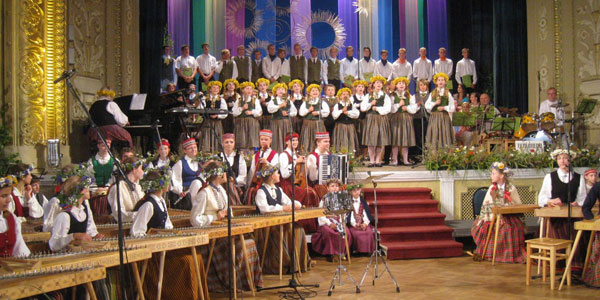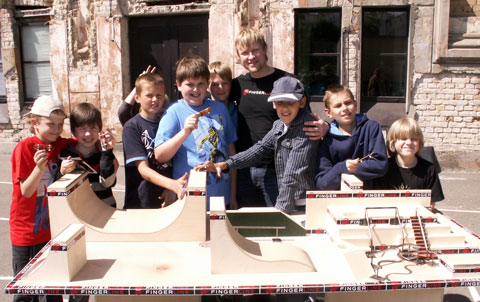
Rīgas Latviešu biedrības namā skolēni dzied un muzicē Tautas muzikas koncertā “Saule sēja sidrabiņa”. (Foto: Arnis Gross)
Šajās dienās, no 6. līdz 11. jūlijam, Rīgā dzied un dejo 31 000 bērni un jaunieši no visas Latvijas. Tie visi ir dalībnieki X Latvijas skolu jaunatnes dziesmu un deju svētkos – svētki, kas palīdz nodrošināt, ka jaunākās paaudzes manto dziesmu svētku tradīcijas.
Svētki notiek ik pa pieciem gadiem. Maijā noslēdzās svētku atlases skates un konkursi, kuros piedalījās vairāk nekā 100 000 skolēni. Pirms svētkiem, svētku organizācijas centrā tiekos ar svētku izpilddirektori Agru Bērziņu.
Dace Micāne Zālīte (DMZ): Agra, iztēlosimies, ka šobrīd Rīgā ir uzcelti Dziesmu svētkiem vārti, un Jūs stāvat vārtos un sagaidāt svētku dalībniekus, kas brauc no visiem Latvijas novadiem autobusos ar lauku ziedu vītnēm, ar vainagiem, ar tautas tērpiem – ar gribu sniegt savu sagatavoto repertuāru svētku klausītājiem. Ar kādiem vārdiem, ar kādām jūtām Jūs viņus sagaidāt?
Agra Bērziņa (AB): Es sagaidu ar vārdiem: “Mīļi, laipni gaidīti, mīļi aicināti visi svētkos!” Mēs svētkus gaidām patiesi ar lielu prieku, gandarījumu un sajūsmu, jo zinām to lielo darbu, ko ir ieguldījuši skolotāji, lai iedvesmotu, lai aizrautu, lai iemācītu, lai sagatavotu bērnus, jo tas ir pats sākums visai dzīvei. Tas nebūt nav vienkārši – iemācīt palēcienus, pēc tam polkas soli vai galopu. Iemācīt sabalsot un dziedāt ansamblī, dziedāt korī un būt lielajā kopkorī, lai sajustu to dziesmas un mūzikas varu un spēku, kas virmo Mežaparka Lielajā estrādē. Lai sajustu gan kopkora 12 500 balsu dziedājumu, gan lielā pūtēju orķestra skanējumu, kur vienkopus spēlē apmēram 1500 dalībnieku, un lai veidotu šos krāšņos un vienreizējos, tikai Latvijai raksturīgos deju rakstus Tautas deju lielkoncertā.
Mēs visus gaidām, mēs visus aicinām un priecājamies par to aizrautību un iedvesmu, ar kādu bērni gatavojas svētkiem. To visu varēja redzēt pavasarī skatēs: pārdzīvojumus, gaidot rezultātus, un saviļņojumu un prieku, uzzinot, ka viņš ir kļuvis par svētku dalībnieku, un to bērnu sāpes, kuri nebija izturējuši lielo konkursu. Latvijā mēs esam unikāli ar lielo dziedāt un dejot gribētāju skaitu, un tas ir ļoti liels gods – kļūt par svētku dalībnieku. Un tad droši vien var izvērtēt – vai es kā skolnieks esmu apmeklējis visus mēģinājumus, vai esmu mācījusies un darījusi visu, to ko man skolotājs ir veltījis un ir gribējis iemācīt? Vai varbūt arī skolotājs kādā brīdī ir domājis tā mazliet vieglāk pa dzīvi pastaigāt un vienkāršāk uz to lietu skatīties… Latvijā demogrāfiskā situācija ir diezgan skumīga – ar lejupslīdošu līkni, tomēr interešu izglītībā, dziesmu svētku procesā, rudenī bija iesaistīti 100 000 Latvijas skolēnu. Ir tādi, kuri dzied, dejo, spēlē orķestrī, bet kopumā svētkos mēs varam uzņemt tikai 30 000 dalībnieku. Mežaparkā uz estrādes var atrasties vienlaikus 12 500 dziedātāju, Daugavas stadiona ietilpība ir tāda, lai vieni varētu dejotu, bet otri gaidītu savu uzstāšanos.
DMZ: Ir lasītāji, kas dzīvo ASV – tālu no Latvijas, bet viņiem interesē Latvijas kultūra. Lai viņi izprastu šo svētku apjomu, varbūt ieskicēsim faktus un statistiku, kas rāda svētku mērogu, jo tas ir globāli unikāls notikums, ko sniedz Latvijas skolu jaunatne.
AB: Dziesmu svētku skatēs piedalījās no 118 Latvijas novadiem, bet līdz svētkiem konkursa rezultātā dalībnieki netika tikai no pieciem novadiem. Mēs redzam – šeit ir Latvijas visaptveramība, visa Latvija piedalās svētkos. Varbūt kādam tas nav izprotams, bet, lai iekļūtu svētku dalībnieku pulkā, ir jāiziet atlases konkurss, labi jāapgūst svētku repertuārs, jāiztur cīņa par savu vietu. Runājot vēl par mērogu – ir iesaistītas gandrīz visas Latvijas skolas sagatavošanas posmā. Ir novadi, piemēram, Mazsalacas novads, kur nav mājās palicēju, visi, kas gatavojušies, svētkos piedalās, par ko mums liels prieks! Latvijā bērnu skaits samazinās, demogrāfiskā līkne slīd uz leju, un par to ir lielas bažas, bet tieši interešu izglītībā ir paradoksāla situācija, ka procentuāli skolēnu skaits ir vai nu uz vietas, vai pat nedaudz palielinājies. Ar ko mēs to izskaidrojam? Ar to, ka skolēni grib dziedāt, grib dejot, grib kaut ko darīt!
DMZ: To mēs vērojam laikā, kad virtuālais vilinājums bērniem ir tik milzīgs – sākot ar datoriem un citām jaunajām tehnoloģijām. Vai tā nav zināmā mērā izcila īpašība mūsu Latvijas bērniem, ka viņos ir šī tieksme sevi izteikt caur mākslas formu?
AB: Jā, Dace, kā Tu saki, tā arī ir. Tā ir pārmantojamība, un tiem, kas piedalās svētkos, ir emocijas, pārdzīvojums. Viņš ar lielo gandarījumu aizbrauc mājās un dalās iespaidos ar pārējiem, un ļoti daudziem arī gribas tur būt klāt, lepoties: “Jā, es biju 2005. gadā Dziesmu svētkos, es piedalījos 2008. gadā pieaugušo svētkos, un atkal es piedalos Skolēnu Dziesmu svētkos 2010. gadā!” Tā ir tā neizskaidrojamā kopības sajūta, kas ir Latvijā, kas ir tikai mums. Es gribu uzsvērt, ka mēs tiešām lepojamies ar vecākiem, kuri rosina, mudina savus bērnus dziedāt, dejot, aizrautīgi darboties. Mēs lepojamies ar skolotājiem, kuri ir būtībā entuziasti, fanātiķi, brīžiem man pat liekas, ka misionāri, kuri veic savu misijas darbu, iedodot bērnam jaunas zināšanas, jaunas prasmes. Braukājot pavasarī pa Latviju un noskatoties skates un konkursus, mēs sajutām lielo gribu un vēlmi – būt Rīgā, būt svētkos! Vienalga, cik grūti ir klājies, tomēr gribas būt klāt un būt kopā, neslīgt depresijā, bet izjust svētku gaidīšanas laiku un izjust svētku prieku!
DMZ: Jums ir bijusi tikšanās ar desmitiem tūkstošu svētku dalībniekiem, braukājot pa Latviju, noskatoties skates, priekšnesumus. Kā Jūs varētu raksturot Dziesmu svētku dalībniekus, viņu rakstura īpašības?
AB: Visi bērni ir smaidīgi, viņi visi ir laimīgi un ar starojošām acīm!
DMZ: Viņos Jūs nejūtat to, ka viņi ir stresā par to, kā viņi uzstāsies? Vai viņi ir laimīgi šajā procesā?
AB: Viņi ir laimīgi ,un tik, cik man ir nācies satikties un saskarties, redzu, ka dalībniekos darbojas tas milzīgais gaidīšanas prieks un satraukums, saviļņojums, jo viņi grib būt klāt Dziesmu svētkos! Viņi ir ar tādu starojumu, mirdzumu un ar attieksmi – es dziedu priekam!
DMZ: Kāds ir repertuāra pamats Dziesmu svētkiem un kā tas veidojas?
AB: Repertuārs top diezgan tradicionāli. Lai izveidotu skaistu koncertu, repertuārā iesaista gan zināmas dziesmas un dejas, kas ir dejotas iepriekšējos svētkos, pat no tiem svētkiem, kad es biju maziņa, kad mēs abas bijām maziņas, gan gluži jaunas – īpaši veltītas šiem svētkiem. Svētkos varēs izjust tā laika dejas raksturu un formu. Šogad būs skaisti jaundarbi, piemēram, ar dzejnieces Ineses Zanderes vārdiem ‘’Upju dziesma”, kuri izskanēs koncertā “Radītprieks”. Veidojot repertuāru liela vērība tiek pievērsta – vai tas ir laikam atbilstīgs, vai ir saglabātas klasiskās vērtības, vai ir dziesmas un dejas, kas pašiem bērniem patīk!
Man bija liels pārsteigums, kad bērni teica, ka grib dziedāt 1886. gadā komponista P. Jurjāna sarakstīto kantāti “Tēvijai”. Bērni ar asarām acīs apgalvo: “Man patīk!” Šajā pavasarī intervijās svētku dalībnieki saka – mīļākā dziesma ir J. Vītola :Gaismas pils” ar Ausekļa vārdiem. Tātad viņu dvēselēs un viņu personībās Latvijas mīlestība un patriotisms ir dzīvs, un viņi to paudīs!
DMZ: Kur jums tik brīnišķīgi dzima ideja par svētku simbolu un svētku moto – vilciņš? Iegriez vilciņu – par enerģijas tapšanas mirkli, kad sanāk visi kopā ar labām domām.
AB: 2007. gadā tika izsludināts konkurss par svētku koncepciju. Režisorei Ingai Krišānei bija ideja par svītru kodu – par to, cik mēs katrs esam dažādi. Mūsu dzīve veidojas dažādās svītrās un joslās, tā mēs veidojam savus darbus, savu mākslu. Tad sekoja logo konkurss, kurā uzvarēja māksliniece Antra Auziņa no Talsiem ar ideju par latvieši bērnu rotaļlietu vilciņu – “tas rūca , dūca, dancoja, tas dziedāja un smējās…” Tā ir ievirpuļošanās, skanējums, kustība, dzīvība, viss, kas mūsu bērniem ir apkārt.
DMZ: Es domāju, ka Rīga, Latvija, pasaule būs ļoti aplaimota no diviem tik stipriem spēkiem; svētki, ko rada bērna enerģija, jaunieša tieksme būt tādā pilnziedā pasaulē. Šinī brīdī viņiem tiek ielikta lūpās dziesma, kājās deja un rodas apbrīnojama enerģija, un viņi ar šo enerģiju svētīs visu Latviju, savu tautu, savus vecākus, kas viņus līdz šim punktam ir aizveduši. Savus skolotājus. Ko Jūs vēl gribat pateikt, svētku vārtos stāvot un bērnus sagaidot?
AB: Lai šis mūsu dziesmu, deju, krāsu, rakstu virpulis, kas iegriezīsies svētku laikā, palīdz sasparoties, nezaudēt optimismu un cerību tam, ka ar kopējo visu svētku dalībnieku spēku var padarīt lielas lietas! Un mēs varam parādīt ikvienam, ka bērnos Latvijā ir spēks un Latvijas jaunieši ir spēcīgi, zinoši, gudri, varoši! Es novēlu izturību svētku nedēļā- tas nekas ,vai spīdēs karstā un sildīs mūs svelmainā saule, vai uzlīs kādas lietus piles, bet kopumā visam jābūt labi. Un jābūt kopīgai svētku sajūtai un izturībai.

Agra Bērziņa






